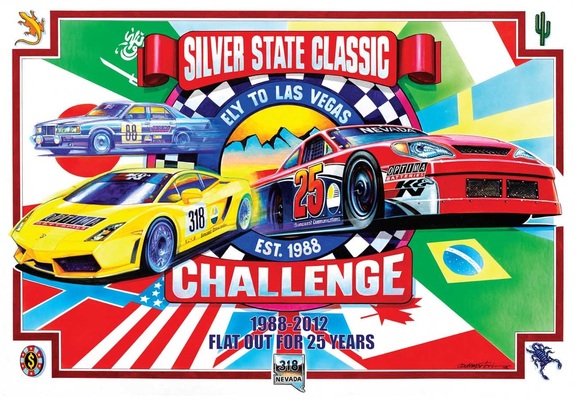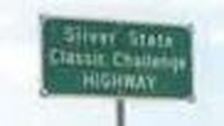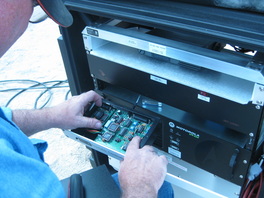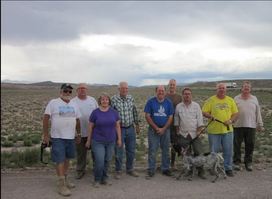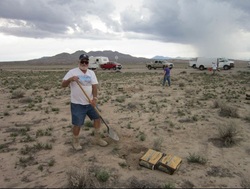silver state hams become "free masons"
Halfway between mid-night and sunrise they left their homes and travelled under the cover of darkness. Either alone or in pairs the chosen twelve rode thru the night, their homes in Ely, Mesquite, and Las Vegas fading away in their rear view mirrors. Ahead of them, an isolated desert rendezvous.
The black pitch of night was just giving way to the gray shades of dawn when the conclave assembled. By days end they all would become "Free Masons".
The twelve are all ham radio volunteers for the Silver State Classic Challenge races. Their mission was to test and make improvements to the portable repeater system which they use for the twice a year SSCC events along the Silver State Classic Challenge Highway also known as Nevada 318.
The black pitch of night was just giving way to the gray shades of dawn when the conclave assembled. By days end they all would become "Free Masons".
The twelve are all ham radio volunteers for the Silver State Classic Challenge races. Their mission was to test and make improvements to the portable repeater system which they use for the twice a year SSCC events along the Silver State Classic Challenge Highway also known as Nevada 318.
The Silver State Classic Challenge is recognized by the Guinness Book of World Records as the fastest highway race in the world. Each May and September racers from all corners of the globe descend on Ely, Nevada to participate in the Silver State Classic and it's sister race the Nevada Open Road Challenge.
More than 120 miles of open highway is shut down for the running of these races. Top speeds of more than 250 MPH have been achieved on the 90 mile racing section of the road.
While the SSCC boasts one of the best safety records in high speed motor-sports, accidents, including fatalities have occurred. Therefore, efficient and dependable communications are a must for this remote piece of desert real estate.
For more than 26 years the task of providing this reliable resource has fallen upon volunteer ham radio operators.
More than 120 miles of open highway is shut down for the running of these races. Top speeds of more than 250 MPH have been achieved on the 90 mile racing section of the road.
While the SSCC boasts one of the best safety records in high speed motor-sports, accidents, including fatalities have occurred. Therefore, efficient and dependable communications are a must for this remote piece of desert real estate.
For more than 26 years the task of providing this reliable resource has fallen upon volunteer ham radio operators.
Fourteen ground stations and two fixed wing aeronautical stations manned by amateur radio operators provide the primary communications network. An additional 60+ Course Workers along the road report via FRS radios to the ham operators. The hams utilize 3 linked roadside repeaters as their primary system and 3 linked mountain top repeaters as a backup.
In the past, winds in excess of 60 MPH have buffeted the antennas and masts of the portable repeaters. This resulted in not so vertical antennas and beams oriented more for communicating with the International Space Station than with the link repeater.
In the past, winds in excess of 60 MPH have buffeted the antennas and masts of the portable repeaters. This resulted in not so vertical antennas and beams oriented more for communicating with the International Space Station than with the link repeater.
Armed with picks, shovels, and 3,500 lbs of concrete and water carried from Las Vegas 200 miles to the south, the volunteer crew set out to eliminate this problem by mixing, pouring, and floating cement mounting slabs and anchoring pads.
By mid-afternoon, storms were in progress on both sides of the volunteer work party. Lightning was striking close by. Flash flooding and mudslides the night before had closed a portion of Highway 318.
Mother Nature was threatening to deliver a "one-two" punch as the group arrived at the last repeater location.
Holes were hastily dug, bags of concrete and buckets of water were hefted and ported into the desert, cement was mixed, poured, and finished, anchors were set, and dirt was shoveled over the slabs in an attempt to blend the installation back into the desert soil.
All of the equipment had been set up, tested, torn down, and stowed. Twenty slabs had discretely been installed into the desert floor.
Sore, tired, hungry, sun and wind burnt, the "Free Mason Hams" began their treks home....just as the sky began pelting their windshields.
"It was a Great Day for Ham Radio!"
Mother Nature was threatening to deliver a "one-two" punch as the group arrived at the last repeater location.
Holes were hastily dug, bags of concrete and buckets of water were hefted and ported into the desert, cement was mixed, poured, and finished, anchors were set, and dirt was shoveled over the slabs in an attempt to blend the installation back into the desert soil.
All of the equipment had been set up, tested, torn down, and stowed. Twenty slabs had discretely been installed into the desert floor.
Sore, tired, hungry, sun and wind burnt, the "Free Mason Hams" began their treks home....just as the sky began pelting their windshields.
"It was a Great Day for Ham Radio!"
